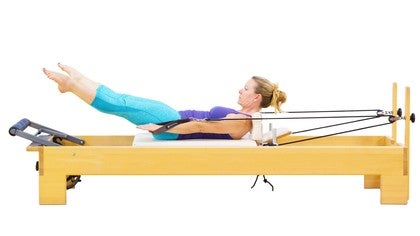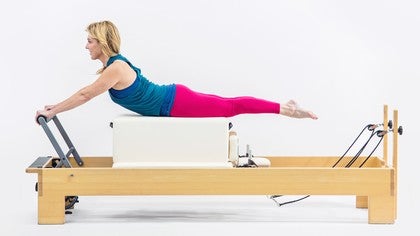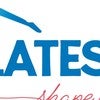Description
Muscle Focus: Abdominals.
Objective: Spinal articulation and strengthening the abdominals.
Reformer Setup: Start with 1.5 to 2 springs. Short Spine Massage becomes more challenging on a lighter spring setting. Lower the headrest to flat, footbar is up.
Start Position: Lie flat on your back, and place both feet onto the footbar. Press out and carefully place the leg straps over one foot and then the other. Then press both arms firmly into the carriage. Legs start in frog position, with both heels together, knees shoulder width apart.
Movement: Reach the legs out to a 45 degree angle, straight and together. Fold at the hips to bring both legs towards you, still straight and pressed together. Once the carriage comes into the stopper, use the abdominals to roll through the spine up to the shoulder blades. Reach your sitsbones to the ceiling to create a long spine and lift from the abdominals. Both arms are pressed firmly into the carriage throughout. Bend both knees towards the shoulders, opening them shoulder width apart while keeping both heels glued together. Keeping the feet where they are, roll down through one vertebra at a time back onto the carriage until the legs are at about a 90 degree angle. Press the tailbone into the carriage and return the legs to the starting frog leg position. Repeat two to four more times.
Precautions: Ensure that the headrest is flat prior to starting this exercise. This is an intermediate/advanced exercise that should not be performed by anyone with neck or spine injuries.
About This Video
Transcript
Read Full Transcript
Hi, I'm Sarah, and we're going to take a look right now at the short spine. And the shorts point is a tricky exercise. It happens to be one of my absolute favorites, but it also is one of those ones that you really need to have all your pieces in order to do safely. So make sure that you feel quite comfortable in this exercise when you try it. If for any reason you don't feel comfortable or it doesn't feel like a good idea, save it for another day. There's plenty of things to choose from.
But today we're going to talk about how to make it feel a little better and hopefully try to understand some of the nuances of the exercise. First and foremost, we have to deal with safety. Anytime you're lifting your hips above your head, it's absolutely imperative that the headdress be flat to ease up any excess stress on the cervical spine or on the neck. So please make sure that your head rest is flat. Before you begin, I want you to know that I have Christiana Red Spring and a blue spring, which is a pretty light spring. Um, however you want to be careful not to go too light or too heavy here. If you're a bigger person, a longer person, or a heavier person, two red springs would be okay. For me, that's about the heaviest I would work.
And if you're a very light person and you want to challenge yourself a little bit more, I should say, and, or you want to challenge yourself, certainly you could do this on one spring, but I think one red and one blue feels good or perhaps a green and a blue would feel really good. So we have our flat head rest, always important to remember. And we have a red and a blue screws spring. Um, you should take care in how you put your feet in straps. So I want you to first retrieve the straps from by your ears with both feet on the bar, press your legs out to straight, and then put one foot in that strap holding, uh, the weight of the carriage with the one-foot. Go ahead and lift the other foot away and then put that foot and strap. So it's important to feel comfortable here before you even think about the short spine and know that the short spine, while the uh, straps are attached to your feet, as with all these exercises, the focus is really your core.
So don't get caught up in where the feet are aware of. The spring is attached if you will. And I say spring is attached because you have a strap on your feet that attached to the spring. Okay. Just so you're aware of that. Um, but focused really on what's going on from the inside out. Our first picture is in the frog position, like so, so we've got neutral spine arms are heavy by side and we wanna really work here on setting the intention of being involved in the upper body. And for me that means that the chest is open and the arms are weighted, are heavy. It's not a real active pushing, although it is really okay for the arms to be involved in this exercise.
In fact, they need to be picture number one is here, picture number two, we press the legs out to straight. Now here, this is a comfortable position because most likely we've done the frogs. Picture number two, we're going to fold it the hips and we're going to bring the carriage all the way into the stopper. I suppose it's important at this point to mention that various different people do this exercise in different ways. I'm going to ask you to come all the way to the stopper before actively rolling up. Please notice that Christie's bottom is off the floor of the mat, but she's not actively rolling up yet. Okay?
There are other ways of doing this and they're all wonderful, but this is the way I'm going to ask you to do it today or guide you to do today. Notice that the feet are um, actively together. The legs are straight from here. We engage those abdominals and we roll up onto the shoulder blades, keeping these legs actively in rotation and together. Knees are straight. Notice here we've got a long spine. This is called short spine, but her spine is long. She's got this long.
See that goes all the way out through her feet. And then we bend the knees. The knees are open about the width of the shoulders. Okay, and then here we're going to roll down through the spine, one vertebrae at a time. Notice that the legs open a little. Once we find basically that frog shape that stays still and we continue moving the pelvis back to neutral and we find our frog. Okay. Now we're going to dig a little deeper in each position. Pressing the legs to straight. This is the frog.
I like to use an exhale here we're going to fold at the hips. This is an inhale in theory, but if you need to take a second breath, please take a second breath. Notice we keep this shape of the feet and these long legs. This part is important. Don't press up solely with your arms. Feel the opposition of softening down your rib cage, your upper back to engage your abdominals, to bring your pelvis off the mat and then here take the moment and pay attention to your arms heavy.
You can actually press a little bit with your arms to help elevate the body slightly more. However, notice that we're still in a round back here that we haven't straightened out the back, but you're still using the abs here to keep flection in the spine. Also notice that there's not a whole lot of weight on the head. That was a funny angle. People, he'll put my head here. There's not a whole lot of weight on the head. It's really shoulders and the arms bearing in the majority of the weight here.
Ben, the knees, the legs don't flop down. There's still a little bit of tension on the ropes. Inner thighs working to keep those heels together and then we articulate down through the back once again feeling that the backs of the ribs lead the way the low back goes down the legs open to about 90 degrees and then we pull through using the abdominals. Good. Didn't cue the flex, but that is exactly what I wanted to cue there. So I have one more piece I want to talk about here. Press the legs out to straight. The feet start flex. Let's go back actually.
So here the feet usually start flexed. You push your legs out to straight, and then we point the feet. The reason we point the feet has mostly to do with keeping the straps on has so the foot flexing and pointing can be an add on. Once you really understand the exercise, as far as I'm concerned, we're going to fold it. The hips, it looks prettier with pointed feet here to here. It sends the opposition down with the ribs up with the rest of the body. Beautiful heaviness through the arms. Think about this, my friends, if you can get both sides of your wrists to get heavy as well, you might feel something. Wake up in the back of your arm that feels yummy.
Bend your knees without flopping down. We want to keep tension on the ropes and then we roll down as far as we can without moving the carriage. And then this is the point where sometimes we lose the ropes a little bit a the straps. So if you flex your feet, it helps keep those straps on and it's going to bring you a little bit more into the outer glute or the deep rotators. So here we are at picture one. Exhale, press out to straight. The feet are pointed, we folded the hips all the way till we touched the stopper. Now pause here for just a moment. Christie.
Really pay attention to not moving the carriage when you go up. That's important for me. When you bend your knees, you want to keep tension on the ropes, but also keep the carriage at rest if you can. And now here as you roll down, the carat stays home as long as possible. Then we flex the feet and we only start to move the carriage when we have to. But we're moving with our core, not with our feet. Beautiful. Let's do this again. Press those legs out to straight, pointing the toes, folding at the hips until we touch the stopper again.
Pay attention to keeping the carriage still all the way up. Nice. We bend the knees here, staying connected to the apps and then as you lower down, it's a combination of the abdominals and the back. Keeping the carriage home as long as possible. And when you start to move through, make sure it's with the core, not by moving the feet through in your mind. So once again, remember that as we do the short spine, just like with pretty much any exercise in Pele's, we don't want to pay attention so much to the outside of what's moving or the far away points, meaning the feet. We want to feel it start from the core and then the movement extends out through the rest of the body, whether it be the arms or the legs.
Here with flex feet we press the legs. That's the exhale and now we point, we folded the hips all the way till we touched the stopper. Using the opposition of the ABS to roll up. We've been the knees, that's the we roll down with control again, supporting with the ABS, but really the back muscles are working. Flex the feet here and pull through. Keep those adductors on one more exhale, point the feet, fold at the hips till we touch the stopper with control. Exhale to roll up. Feel, taste it. Bend the knees. That's the inhale. Exhale to roll down. Enjoying that articulation through your back.
Flex the feet as you pull through. That's the inhale in theory, and we're right back where we started from. Thank you for watching.
Exercise Breakdowns & Tips: Reformer Exercise Breakdowns
Comments
You need to be a subscriber to post a comment.
Please Log In or Create an Account to start your free trial.




















